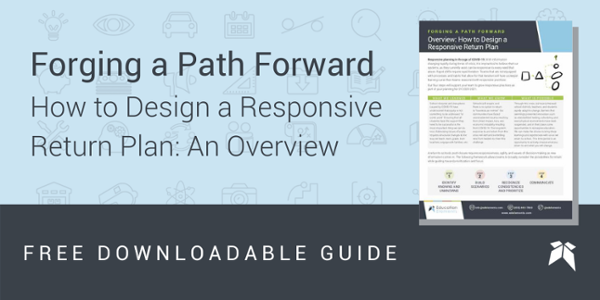
scenario planning to develop a responsive school return plan
strategic planning | crisis management | district leadership
when i was younger, my mother and i would sit for hours playing the game mastermind. it’s a game of logic, where one person sets a code using a pattern of six colors, and the other tries to guess the code. according to wikipedia, there are over 1296 patterns that can be made - and the person guessing only has 12 tries to crack it.
right now it can feel like we are in an endless game of mastermind, where there are seemingly 1296 different scenarios for what school can look like in this next year. but in reality, there isn’t actually a hidden code somewhere, and i doubt there is even a “right way” to plan. this would have been impossible for 10-year-old simma to comprehend – after winning most of my mastermind matches against my mom, i always thought there was a way to crack the code.
our challenge right now is to unlearn that there is a single winning scenario to plan for next year; there is no logic that can help us to crack the code when there is so much uncertainty. scenario planning is a process that helps leaders to consider a variety of future realities. as a team, we imagine and prepare by constructing a few possible scenarios – no physical distancing required, physical distancing required, and distance learning required.

depending on state guidance, density of population, and the current prevalence of covid-19, some districts have found it beneficial to build multiple scenarios that fall within each of these categories. and to complicate things further, there is a real possibility that districts will flow through multiple scenarios in sy 20-21. therefore, it is beneficial for your team to prepare for different scenarios (even ones that may seem implausible for august, like school with no physical distancing) so that they can flow more quickly between them if necessary.
within these constraints, your team is free to imagine how the needs of students, staff, and families may change. this opens up the opportunity to rethink current processes, systems, staffing, and operations to respond to the needs outlined in different scenarios. here are some practices we’ve incorporated into our scenario planning for sy 2020-2021.
gather data quickly to bring more clarity into the unknowns
as a team and across our clients, we consistently conduct pulse checks. this allows us to incrementally gather information to make smaller decisions and gain clarity on some of the biggest unknowns. for example, as we consider the comfort level of parents to send their kids back into school buildings, we encourage you to make fewer assumptions by asking more questions. when we send out pulse checks across the 瑞士vs喀麦隆亚盘赔率 team, we started experimenting with video so that our team members can express their thoughts in 2 minute clips instead of filling out surveys. we have also found it helpful to gather data from other industries and other countries, which helps to guide decision points as well as potential solutions.
engage stakeholders with specific roles
as planning continues to take shape, scenario planning grows from living in conversation across a small circle of leaders into a larger group of problem solvers, influencers, and questioners. john kotter describes this transition as moving from a “guiding coalition” towards a “volunteer army” through his 8-step process for leading change. gaining buy-in for the scenarios and the resulting plans for instruction, operations, health, and safety starts during the scenario stage. therefore it is critical to provide clear roles to everyone who is involved. here’s an example from one of our current projects.
- coach: leads the scenario development, managing the day to day work
- manager: ultimately accountable for the scenario’s development
- referee: sets the goals and guidelines for the scenario (often an outside organization such as your state department of education or health department)
- players: the staff and departments who implement the scenario
- fans: anyone who is impacted by the scenario (including external partners)
this is the process, not the solution
our final piece of advice is to view the scenario exercise as an ongoing process. as new information arises, coming back to the scenarios will help your team to respond and tweak their approaches. the scenarios will also highlight the major areas of your organization to be re-designed to perform their essential function, most times because the requirements have changed. for example, the essential function of food services may stay the same since they will continue to provide food to students next year. however, their processes will need to be redesigned significantly if the delivery is happening directly to classrooms to limit contact or if meals are sent on buses to homes if no students are in school buildings. scenarios will not only highlight these new requirements but will also help your teams design processes that can support the transition between various scenarios throughout the next school year.
as you tackle return planning and building your scenarios, check out our new abbreviated guide that outlines our four steps to responsively planning your sy 2020-2021 return. reach out with questions and thoughts - we love hearing your comments.



